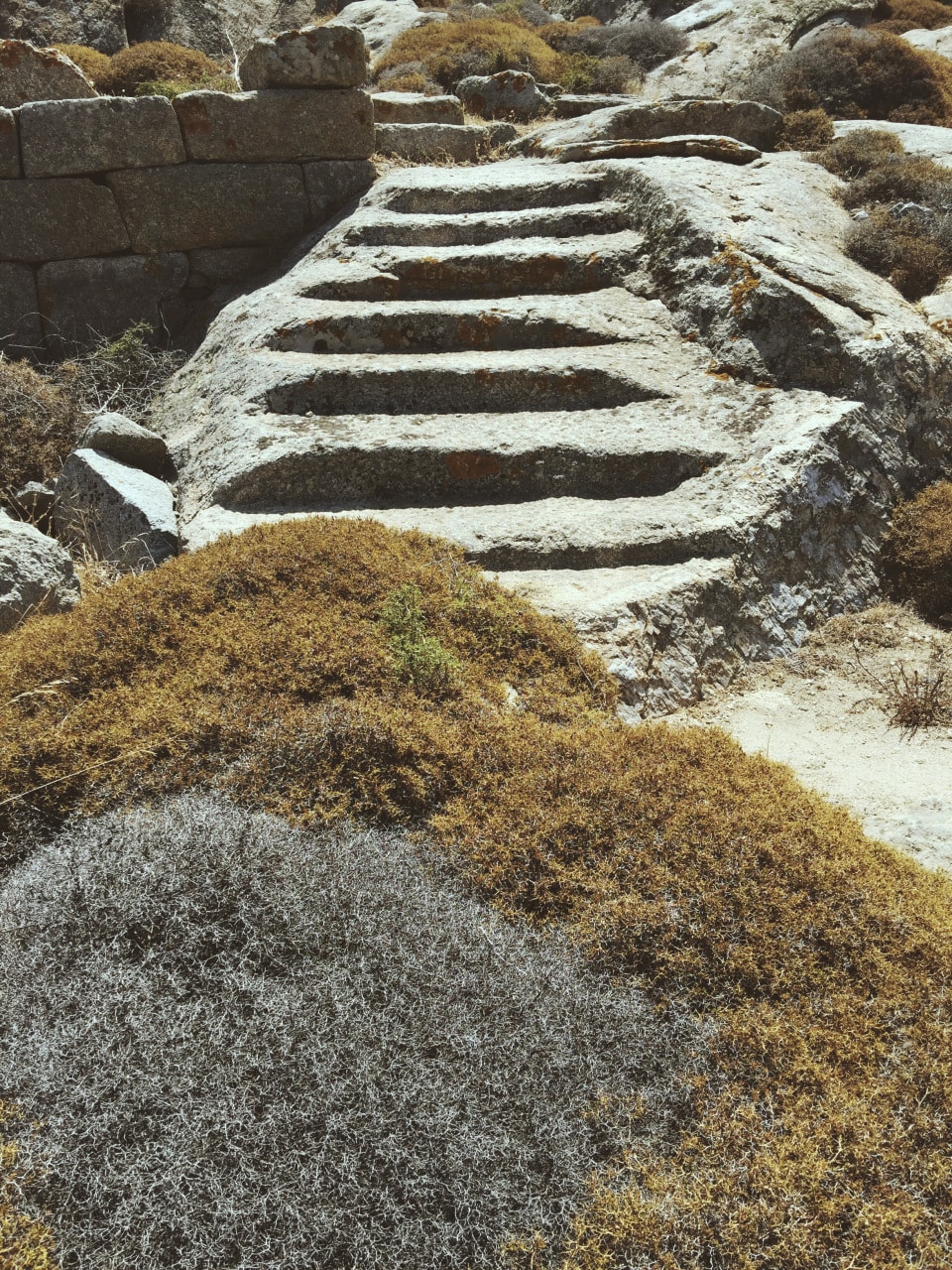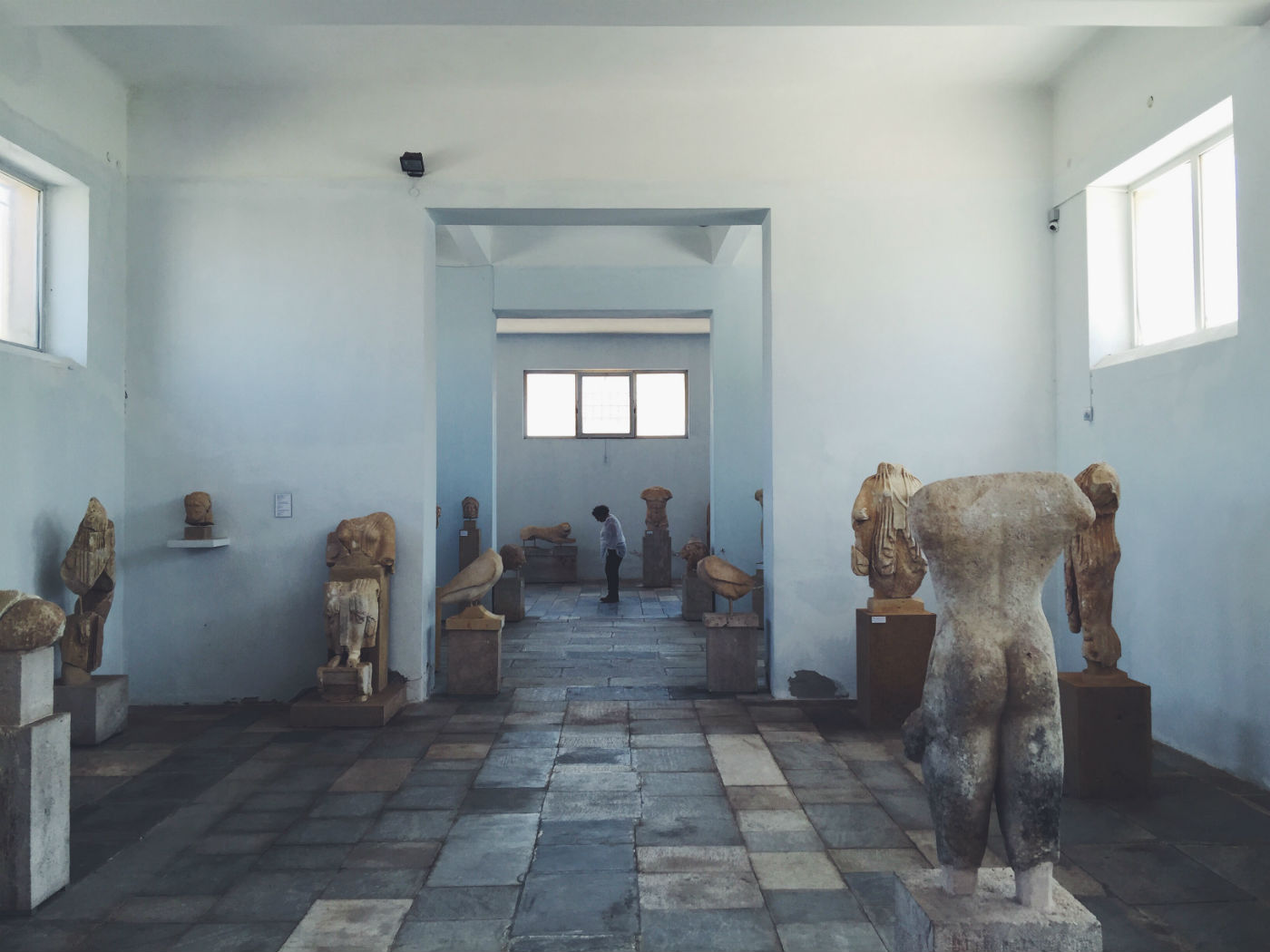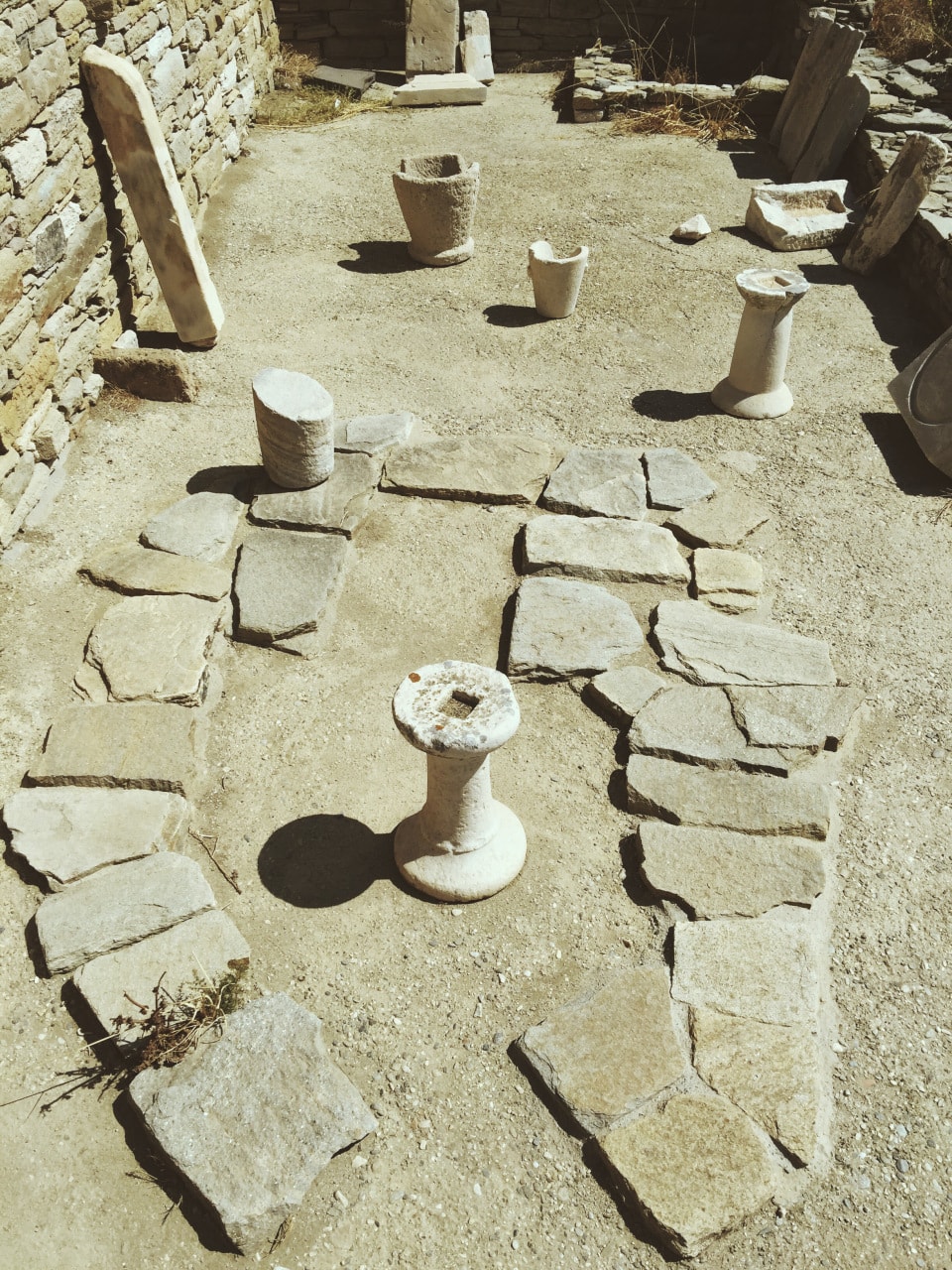Imagine you’re flying in a hot-air balloon over the Cyclades and you’re drifting southwards over the sea. Behind you, Tinos rises like a mountain sculpted by a divine maker, and to your left is Mykonos: a smoother body with rounded hills, small peninsulas and exposed rock formations. The Greek summer wind known as meltémi blows from the north, pushing us over the sea in silence. Far away towards the horizon, a ferry is drawing a line of white foam, heading to Paros perhaps or Naxos. And in the middle-distance, a cluster of islands that seem mysteriously uninhabited. The one to the east, significantly smaller, has a pointy hill standing in its middle, like an obelisk raised to honour a time-forsaken pact. No tree or bush grows here, and the whole island is covered with dry, golden grass and what seem to be like the foundations of a large city: this is the once prosperous sanctuary of the Ionians and home to their patron god of light. This is the sacred land of Delos.

Once a city of 30,000 inhabitants, Delos was considered by the ancients as the birthplace of Apollo and his twin sister, Artemis. Many legends exist as to how Leto, their mother, ended up giving birth there, with my favourite being the one where Zeus, after his love affair with Leto was discovered by his wife Hera, was looking for a safe place for Leto to give birth. There was an island floating around the Aegean, and Zeus ordered it to stop; what a better place to hide your pregnant mistress than an undiscovered island? So this chunk of floating rock came to a standstill next to Mykonos, and turned from ádelon (unknown) to délon (known), providing a nice etymological myth like the ones the Romans seemed to have a taste for. What I love about this story is how a new place came to be in the world not by creation and divine labour (as it’s the case with most stories of how gods make things), but by vocal command and a kind of curation: a rogue island was ordered to stop traveling, and to be turned from a wanderer into a place where one can wander.
As the birthplace of the god of light, Delos attracted huge numbers of pilgrims, especially because Delios Apollo (not to be confused with the Apollo of Delphi, who’s a different deity altogether) was the patron saint of all the Ionians. According to legend, the Ionians were once the indigenous tribe of the Peloponnese, but were chased out of their homeland around 1200 BCE by the Dorians who invaded from the north. The Ionians then dispersed from Attica and the northern Cyclades all the way to Asia Minor, in the area around and south of what is today Izmir in southwest Turkey. Over time, Asia Minor came to be known as Ionia, and although the tribe was scattered across dozens of islands and on the two facing coasts of the archipelago, it retained its common identity: the Ionians purportedly loved democracy, philosophy and art, and spoke their own dialect that set them apart from the other three Greek tribes.

Another thing that bonded them all, generation after generation, was their patron saint and his sacred festival on Delos. Every four years, the Ionians gathered on Delos to celebrate the god’s festival in early June, and reunite with their brethren once again. With the meltémi in their sails, the flotillas of decorated Ionian ships arrived to Delos for the festival from Athens, Asia Minor and all the islands in between, as the tribe rallied on its sacred island once more to pay tribute to their common ancestry. At the sight of Mount Kynthos (the pointy rock in the island’s middle), the pilgrim’s heart was filled with joy and excitement, as they returned to the home of their god, with their children and their children’s children dressed in their best tunics and gowns, bearing gifts to the god of light and his smoking altar.
The sun was already up and scorching by the time I left my hotel and headed down towards Mykonos’s old port. As if by ancient custom, the only way to get to Delos is by boat, and there are two sea-taxi companies doing the trip several times a day. I boarded the ten o’clock boat and climbed to the top deck. Rows of benches were lined facing each other like in a waiting room, only we got to sit under the sun, and at the mercy of the etesians. Gradually, more tourists got on board, and soon the deck was full. We departed for the sacred island, which is now an archaeological park where no residents are allowed except for the guards and archaeologists working on the site. We headed west, sailing around a tiny island just off Mykonos with a little church on it, then turned southwest towards a landmass that looked like a cluster of low hills barely above sea level. That’s Rhenea, the larger sister-island of Delos. The two islands together used to be called Deloi, where Rhenea was Great Delos and the island of Apollo was Small Delos. Indeed, if you see them on the map, the two look like the scattered fragments of the same broken ceramic plate. History has proven that Rhenea was in many ways the inverted mirror-image of Delos: whatever Apollo didn’t like, it was exiled to Rhenea. And there were many things forbidden on his island. To die, for instance.

In 426 BCΕ the Athenians, in a gesture of dominance, assert their power on the otherwise neutral island of Delos and establish their hegemony as the first amongst the Ionians. As part of this event, they purified the island by opening up all the graves within sight of the temple, and transferred the remains to Rhenea where they established a necropolis. Later, they opened up all the other graves, and forbade births and deaths on the island, because they believed that Delios Apollo didn’t want to be associated with the events that open and close the life circle of mortals. Naturally, it was more than theological dogma that made the Athenians enforce this rule: as long as no one was born on the island, there was no way for anyone to claim property there through inheritance. Thus, all of the island’s assets remained property of the god, an immense fortune that included precious metals, land, houses, ships and slaves, and which was being managed by the god’s high priests —that is, Athens-appointed clergy.
It is understandable that a military force like that of 5th-century-Athens would want to control Delos. Because of its religious significance, the town grew into a very busy commercial port, where merchants and slave traders from the entire region (from the Levant to south Italy) would come to do business. Later, the Romans lifted all tolls and levies from the port, turning Delos into the most competitive port in the entire East Mediterranean. The city boomed, and turned into a truly cosmopolitan place where Athenians and other Greeks, Italians, Egyptians, Syrians, Phoenicians, Palestinians, Jews and Samaritans mingled and set up shop. Their gods followed suit, as the foreigners established their own temples alongside the Greek ones: Egyptian gods were worshipped next to the Phoenician ones, and as the years passed they even merged —like for example the Greek goddess Demeter at some point assimilated the Phoenecian Astarte, and the Roman Hercules became indistinguishable from the Syrian god Beelzebub.

A walk around Delos today makes this galvanisation of cultures clear. One after the other, the shrines and temples line entire avenues in what has been a busy and prosperous city. Many of its walls and statues still standing, Delos is to Greece what Pompei is to Italy: a perfectly preserved ancient city where one can walk the same alleys and cross the same thresholds as the original inhabitants did some 2500 years ago. The lush mosaic floors and spacious mansions betray that Delos was a place of luxury. Here, rich merchants and ship owners had their home, as well as priests and public officials, all of whom often decorated their opulent villas with marble statues of themselves and their wives. The walls of these homes were also decorated with frescoes, samples of which are on display at the small Delos museum, and which are the only sample of Ancient Greek painting surviving to this day. Another sign of ancient luxury is the size of the oil lamps found in these houses: a common oil lamp from that era has a single wick, whereas many of the ones found on Delos have as many as twenty, which means the Deleans could afford to burn a lot of oil to keep their nights illuminated.
A lizard runs to hide under a rock as I walk down a rocky path on my way to the boat that will take me back to Mykonos. I can’t help thinking that probably Delos used to be what Mykonos is today. And I’ve written elsewhere that both places exist first and foremost in the fantastical, and that their mythology is stronger than their reality. Squinting in this open-air mausoleum of defeated prosperity, surrounded by dry grassland and blue sea, I wonder who would have ever wanted to come here in the first place —but then again, if this is the birthplace of the god of light, I can see why the sun here is so punishing. Malvina Karali, a Greek journalist who died in 2002, has described the Cycladic light as “monstrous.” Standing on a hill and looking down on what’s left of this city of pleasure, protruding out of the dry soil like sun-bleached bones, I think I understand what she meant.
